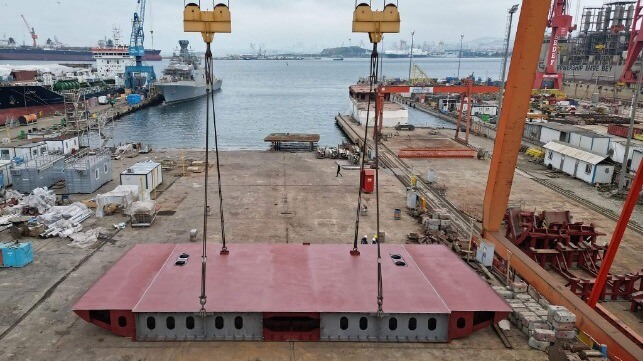Assembly Underway for Unique Wind-Powered Neoline RoRo Cargo Ship

The assembly phase of construction kicked off in Turkey on February 14 for the unique primarily wind-powered Neoliner Origin which plans to start commercial Atlantic service in July 2025. Whereas most of the wind-powered cargo ships built to date are niche projects, the Neoliner is a large vessel that seeks to become a demonstration of the future potential of environmentally responsible shipping. Among the companies involved is Chantiers de l’Atlantique which developed the sails and among the investors is CMA CGM Group.
The construction for the unique vessel went effective a year ago with RMK Marine Shipyard in Tuzla, Turkey, but the companies spent much of 2023 completing details studies. They worked with RMK, Chantiers de l’Atlantique, Muric, and Bureau Veritas, completing designs and plans for the commercial operation.
The first steel was cut in November 2023, Neoline reports that more than 1,000 tons of steel have now been cut and assembled. The first section was placed in the dock on February 14 marking the official start of the assembly of the vessel.
“Since November, the technical team of Neoline Armateur, assisted by Schulte Marine Concept, closely followed the cutting and the first assemblies of the sheets,” said Jean Zanuttini, President of Neoline. “The laying of this first block represents a very important step for us, as the first Neoliner Origin begins to exist, and we see it taking shape day after day.”
The company notes they have reached this step after more than 12 years of work and investment. Neoline Developpement was founded in 2015 followed by the launch of Neoline Armateur in 2021 which is responsible for the commercial operation.

Unlike the current niche sail cargo operations, Neoliner Origin will be larger and maintain monthly crossing starting in 2025
The Neoliner Origin will be 446 feet (136 meters) in length with nearly 3,000 square meters of sail. The vessel will use two Solidsail carbon masts developed and built by Chantiers de l’Atlantique with each mast standing nearly 250 feet (76 meters) and the ability to tilt for clearance and navigation in port. Other unique elements include retractable anti-drift plans and an ultra-efficient weather routing system. Wind will be the primary propulsion for the vessel but it will have an auxiliary engine used while maneuvering or in emergencies.
“Thanks to these innovative technologies and adopting a commercial speed of 11 knots, the Neoliner Origin will achieve fuel savings up to 80 to 90 percent, resulting in a reduction of associated greenhouse gas emissions,” says Zanuttini.
The vessel will have a loading capacity of 1,200 linear meters with a 2.8-meter width or a capacity of 265 TEU. The maximum weight will be 5,300 tons of cargo. The company highlights the design permits the ship to accommodate different types of cargo. There will also be accommodations for 12 passengers.
The construction timeline calls for the assembly to be completed and the sail cargo ship to be floated in December 2024 with completion and delivery in June 2025. From Tuzla, the vessel will proceed to Saint-Nazaire, France, which will be its homeport for monthly Atlantic crossings. They plan to launch the first trip in July 2025 and it will follow a route to Saint-Pierre-et-Miquelon, a French territory south of Newfoundland which will be a stop on both the east and west crossing as well as calls in Halifax, Canada, and Baltimore, Maryland.
Flagship French industrial companies such as Renault Group, Groupe Beneteau, Manitou Group, Michelin, Jas Hennessy & Co, Clarins, Longchamp, Rémy Cointreau, and La Fournée Dorée, have all been reported by Neoline to be among the first customers for the new service.
“With the completion of this project and the demonstration of what modern sailing can bring, we hope to contribute to building a maritime transport more compatible with planetary limits,” concluded Zanuttini.
